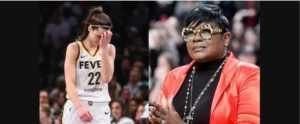Sheryl Swoopes, a highly respected and accomplished figure in women’s basketball, has found herself at the center of a contentious debate. Her criticism of Indiana Fever’s rising star, Caitlin Clark, has sparked a firestorm of reactions, with many calling out Swoopes for her perceived bias and unprofessional behavior.

The controversy began when Swoopes made public statements that inaccurately portrayed Clark’s college career and failed to acknowledge her contributions to the Fever’s recent success. This omission was seen as a snub by many, and Swoopes was quickly called out for her mistake. However, the situation escalated further when Swoopes leaked private text messages with Clark, revealing their personal correspondence to the public. This move was widely criticized, with many viewing it as a breach of trust and a desperate attempt to justify her own actions.
As the backlash against Swoopes grew, notable figures in the basketball world began to weigh in on the issue. Stephen A. Smith and Nancy Lieberman, both respected voices in the sport, publicly criticized Swoopes for her behavior. They argued that her actions were unbecoming of a legend and Hall of Famer, and that she should be more supportive of emerging talents like Clark.
Despite the mounting criticism, Swoopes has refused to back down. She has defended her stance, emphasizing the importance of personal relationships with players and recognizing their achievements. However, her attempts to justify her actions have only added fuel to the fire. Many have accused her of lacking professionalism and credibility, and the situation continues to spiral out of control.
At its core, this controversy highlights a deeper issue within women’s basketball commentary. There is a need for constructive dialogue and mutual respect between established figures like Swoopes and emerging talents like Clark. The sport needs legends like Swoopes to support and uplift the next generation of players, rather than tearing them down.
Furthermore, this situation raises questions about the dynamics of women’s basketball commentary. Is there a lack of understanding and empathy between generations of players? Are there underlying biases and agendas that influence how players are perceived and treated? These are important questions that need to be addressed in order to foster a more supportive and inclusive environment for women’s basketball.
In conclusion, the controversy surrounding Sheryl Swoopes and Caitlin Clark is a complex issue with far-reaching implications. It highlights the need for constructive dialogue, mutual respect, and a supportive environment in women’s basketball commentary. As the sport continues to grow and evolve, it is essential that established figures like Swoopes recognize the importance of uplifting and supporting emerging talents like Clark. Only through a collective effort can women’s basketball reach its full potential and provide a positive and inclusive environment for all players.
